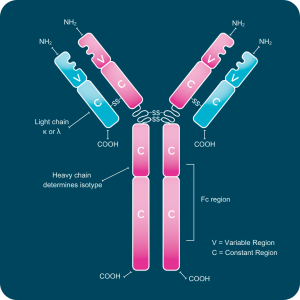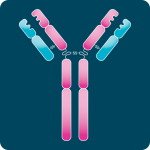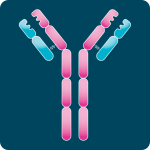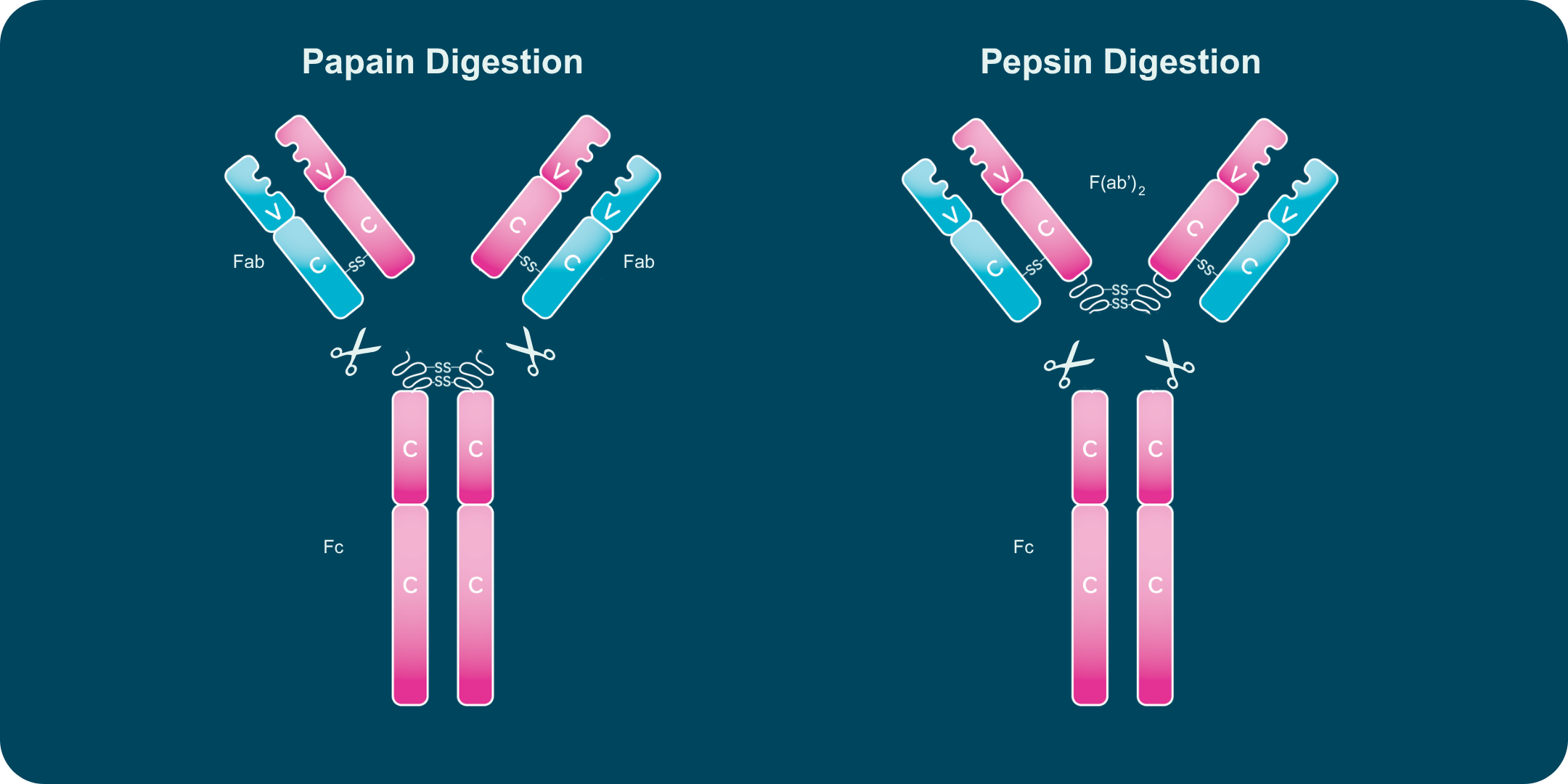Functional Antibodies: Principles for Translational Confidence
A Brief History of the Use of Antibodies in Research
First described in 1890, antibodies, also known as immunoglobulins (Ig), are Y-shaped glycoproteins produced by the immune system to recognize and neutralize foreign antigens such as bacteria, viruses, and toxins. Their remarkable specificity and affinity make them fundamental to immune protection and indispensable tools in biomedical research, diagnostics, and therapeutic development.
Overview of Antibody Structure
 Each antibody molecule consists of two identical heavy chains and two identical light chains. Light chains are categorized as kappa (κ) or lambda (λ) based on sequence differences, while the heavy chain defines the antibody’s isotype.
Each antibody molecule consists of two identical heavy chains and two identical light chains. Light chains are categorized as kappa (κ) or lambda (λ) based on sequence differences, while the heavy chain defines the antibody’s isotype.
Every chain contains one variable (V) domain and one or more constant (C) domains, each composed of roughly 110–130 amino acids. Light chains have a single constant domain, and heavy chains contain three or four. Heavy chains with three constant domains include a flexible hinge region that allows movement of the antigen-binding arms.
A typical light chain has a mass of about 25 kDa, and a heavy chain with three constant domains and a hinge region has a mass near 55 kDa.
Antibody Isotypes and their Subclasses
Antibody isotypes are defined by differences in the heavy-chain constant region, which influence disulfide bonding, glycosylation, and the number of constant domains.
In mammals, five major isotypes exist: IgG, IgM, IgA, IgD, and IgE. In humans and mice, IgG is further divided into subclasses (for example, mouse IgG1, IgG2a, IgG2b, IgG2c, and IgG3). Each isotype contributes distinct biological functions, effector mechanisms, and tissue distributions.
| IgG | IgD | IgE | IgA | IgM |
|---|---|---|---|---|
IgG is the most abundant isotype in serum and exhibits the longest half-life of all immunoglobulins. It includes four subclasses with structural and functional distinctions. IgG1 and IgG3 typically target protein antigens, while IgG2 and IgG4 respond to polysaccharide antigens. Because of its stability and versatility, IgG is the predominant isotype used in research and therapeutic development. | IgD occurs at very low concentrations and has a short half-life. Its exact function remains under investigation, but evidence suggests a role in B-cell activation and regulation. | IgE is the least abundant isotype and has the shortest half-life. It mediates allergic hypersensitivity and provides defense against parasitic infections. Despite its low serum levels, IgE’s ability to engage Fc receptors makes it a potent activator of immune responses. | IgA dominates mucosal immunity. It circulates primarily as a monomer but can form dimers joined by a J-chain and a secretory component that protect it from enzymatic degradation. IgA neutralizes pathogens and toxins and prevents their adherence to epithelial surfaces. | IgM is the first antibody produced during a primary immune response. Individual IgM units assemble into pentamers through disulfide bonds and incorporate a J-chain. Although monomeric IgM has low affinity, the pentameric form achieves high avidity by binding multiple epitopes simultaneously. |
 |  |  |  |  |
F(ab) and Fc Fragment Regions
Each antibody contains two F(ab) regions and one Fc region. The F(ab) regions form the antigen-binding arms, while the Fc region mediates effector functions through receptor and complement interactions.
Papain digestion yields two F(ab) fragments and one Fc fragment. Pepsin digestion produces an intact F(ab′)₂ fragment and a degraded Fc fragment. Because F(ab) and F(ab′)₂ fragments retain antigen-binding capability without Fc-mediated activity, they are useful in imaging, blocking assays, and detection applications.
Conclusion
Antibodies are central to both immune defense and experimental biology. Their structural diversity and functional specialization enable precise investigation of signaling, modulation, and therapeutic mechanisms across in vivo, ex vivo, and in vitro systems. These properties make antibodies essential tools for advancing discovery in immunology, oncology, and translational research.
Functional Antibodies: From Detection to Biological Modulation
History of Functional Antibodies
Antibodies are best known for their ability to recognize and bind specific antigens, a property that makes them indispensable in both research and clinical settings. Yet, antibodies are far more than a detection tool. Many antibodies possess functional activity and are actively able to shape biological processes such as cell activation, toxin neutralization, and modulation of immune pathways.
This capacity was first recognized by Paul Ehrlich in the late 19th century, when antibodies were described as “antitoxins” capable of neutralizing harmful agents.1 Today, functional antibodies remain central to disease research and therapeutic development, enabling scientists to probe and manipulate complex biological systems such as in vitro organoids, organs-on-chip, 3D cell and 2D tissue cultures, and in vivo models.
What Are Functional Antibodies?
The term “functional antibody” is commonly used to distinguish antibodies with biological activity from those employed as inert detection reagents. Although the definition is broad, a functional antibody can be understood as one that actively modulates a biological process in a living system.
Mechanisms include:
-
- Activation or inhibition of receptors and pathways
- Neutralization of toxins, cytokines, or pathogens
- Engagement of Fcγ receptor signaling to direct immune responses
The versatility of functional antibodies allows researchers to explore disease mechanisms, create new models, and identify potential therapeutic strategies.2
Takeaway: Functional research requires antibodies validated for biological activity, not just detection.
Functional Antibodies in Action
Agonist and Antagonist Activity
One well-studied example is the use of anti-CD3 antibodies. These can act as agonists, stimulating T cell activation even in immunosuppressed conditions.3 Conversely, inhibitory antibodies such as anti-PD-1 block suppressive checkpoint pathways, reactivating T cells to attack tumor cells.3
Neutralization
Antibodies can neutralize harmful molecules by binding their active sites, preventing downstream interactions. Neutralizing antibodies play roles in blocking toxins, cytokines, and pathogens, and they are critical for vaccine efficacy because they drive post-immunization immune protection.4
Fcγ Receptor–Mediated Signaling
Functional antibodies may exert effects through Fcγ receptors on immune cells. These interactions can promote phagocytosis, upregulate cytokine production, and direct B cell selection and survival.5 Such mechanisms are especially important in cancer immunology, where antibody-driven Fc engagement can amplify anti-tumor responses.
Ensuring Quality in Functional Antibody Studies
-
- Selectivity and specificity: Off-target binding can activate unintended pathways and confound data.1 2
- Purity and formulation: Endotoxins, preservatives, or aggregation may induce non-specific immune effects.3 4
- Reproducibility: Lot-to-lot variability contributes to irreproducibility in preclinical research studies.6
- Pathogen safety: Antibodies contaminated with murine pathogens can compromise animal health, distort immune responses, and undermine study validity.
- Scalability: Consistent quality and reliable supply from milligram to gram quantities ensures that results remain valid as studies progress from early discovery to large-scale in vivo models.
High-quality reagents minimize these risks, ensuring that data accurately reflect underlying biology.
The Bio X Cell Approach to Functional Antibodies
InVivoMAb™ and InVivoPlus™ antibodies are specifically formulated for in vivo studies and in vitro translational studies using organoids, organs-on-chip, and other new approach methodologies (NAMs). Each lot of antibody is ultrapure, features low endotoxins, and is preservative-free. InVivoPlus™ antibodies undergo additional testing and purification to ensure even lower endotoxin levels (greater or equal to 0.5EU/mg). Each primary antibody has a complementary matching isotype control available to help separate target-driven activity from background Fc effects for your studies.
To further support research your research continuity and reduce time loss due to unstable or inconsistent reagents, Bio X Cell antibodies include a one-year shelf-life stability guarantee. This guarantee ensures stable antibody performance throughout your long-term, multi-phase studies.
Setting consistent and reliable standards for functional antibodies helps ensure that antibodies perform as intended, enabling reproducible, reliable results across both in vitro systems and in vivo models.
With 100% PhD-level technical support, available worldwide, our “for scientists, by scientists” approach to catalog target selection, antibody validation, and QC data review helps ensure the antigen and clone you choose are the best possible fit for your experiments. With industry an industry leading citation record, widely cited PD-1 clones for your model, and novel antibody formats such as bispecific antibodies, we are able to support your next set of studies so you can focus on generating impactful results.
Conclusion
Functional antibodies are vital research tools that make it possible to model disease, dissect immune pathways, and identify therapeutic strategies. Their versatility is unmatched, but the reliability of their insights depends on rigorous study design and high-quality reagents.
With thoughtfully validated antibodies such as those in the InVivoMAb™ and InVivoPlus™ product lines, researchers can create experiments that reveal true biology, accelerate discovery, and build a foundation for translational breakthroughs.
translationally meaningful results.
References
- Daëron M. The effector functions of antibodies. Immunol Rev. 2024;328:6–12.
- Uhlén M, et al. A proposal for validation of antibodies. Nat Methods. 2016;13(10):823–7.
- Menon AP, et al. Modulating T cell responses by targeting CD3. Cancers (Basel). 2023;15(4):1189.
- Zhang A, et al. Beyond neutralization: Fc-dependent antibody effector functions in SARS-CoV-2 infection. Nat Rev Immunol. 2023;23:381–396.
- Bournazos S, et al. Signaling by antibodies: Recent progress. Annu Rev Immunol. 2017;35:285–311.
- Baker M. Reproducibility crisis: Blame it on the antibodies. Nature. 2015;521:274–276.
Why Functional Antibody Standards Are Unique
Functional antibodies are powerful tools that enable researchers to activate, block, or fine-tune biological pathways in complex in vivo model systems. Their impact depends on more than binding specificity alone. Whether to recapitulate disease in vivo, neutralize targets, block receptors, or probe immune pathways, high-quality antibodies at scale are essential to ensure reproducibility, prevent costly setbacks, and drive translational research toward therapeutic impact. Bio X Cell is the global leader of functional antibodies, with an industry leading 30,000 citation record and a nearly 30 year history in providing researchers with high-quality functional antibodies across in vivo and in vitro model systems.
In addition to their utility in traditional in vivo models, our antibodies also feature a unique formulation which is also optimized for sensitive in vitro systems such as organoids, organs-on-chip, spheroids, 2D/3D cultures and other NAM systems.
As the global leader of functional antibodies, Bio X Cell has created a comprehensive framework that defines the critical elements of quality in antibody selection for functional studies. This framework, The Five Pillars of Functional Antibodies, describes the role of specificity, purity, scalability, reproducibility, and community validation in the antibody selection process, pushing the definition of quality beyond basic binding validation to encompass performance across living systems, including organoid and other complex translational models.
The 5 Pillars of Functional Antibodies
Functional antibody research requires more than reagent availability. Reliable, translational discovery depends on reproducible results, outcomes that are directly influenced by antibody quality, formulation, and validation.

Antibodies must precisely recognize their intended antigen without cross-reactivity. Off-target binding may result in the activation or inhibition of unintended pathways, creating misleading and difficult to replicate results. High target selectivity and well-characterized antigen specificity are foundational for functional antibody studies.
Best Practices
-
- Verify application-specific validation data
- Confirm species reactivity and cross-blocking studies
- Use RRIDs for traceability across publications
For in vivo and in vitro organoid studies, antibody purity directly impacts study safety and interpretability. Endotoxin contamination provokes cytokine release and background inflammation that can obscure antibody-driven biology 1 2 3. Protein aggregation can cluster receptors and distort signaling, while preservatives or carrier proteins may compromise viability or interfere with downstream assays 4 5. For functional studies, especially in immune-sensitive systems, low endotoxin levels, low aggregation, and carrier-free formulations ensure that results reflect true target engagement and clean pharmacology.
Best Practices
- Select high-purity antibodies with aggregation and murine-pathogen testing
- Verify lot-specific endotoxin data
- Avoid preservatives in live-cell and in vivo systems
- Choose reagents produced under low-endotoxin processes
- Use carrier-free formulations for translational work
Practical Notes on Endotoxin
Endotoxin is measured in endotoxin units (EU) per milligram of protein. Even low levels can trigger cytokine responses in vitro and in vivo; setting stricter thresholds helps ensure results reflect true biology 1 2.
As studies expand from milligram-scale pilot experiments to gram-scale preclinical work, consistent quality and reliable supply are essential. Lot continuity and forward planning reduce repeat experiments, prevent costly setbacks, and protect animal welfare. Bio X Cell antibodies include a one-year shelf-life guarantee, ensuring stable performance throughout long-term, multi-phase studies.
Best Practices
- Plan for lot bridging with retained samples for comparability
- Forecast multi-phase study needs to secure uninterrupted supply
- Select suppliers with proven scalability (e.g., Bio X Cell 2,000 L/month capacity)
Lot Bridging in Practice
When a lot change is unavoidable, running a comparability panel on retained aliquots can confirm activity before scaling up. This minimizes unexpected variation and avoids costly resets.
Reproducibility safeguards both credibility and resources. Inconsistent antibody performance is a leading contributor to irreproducibility in preclinical research 6 7 8. Validation in the intended application, standardized QC, and transparent reporting are critical to ensure dependable results.
Best Practices
- Rely on lot-specific Certificates of Analysis (COAs)
- Check functional validation data in the relevant application
- Use standardized controls and reference protocols across labs
Best Practices
- Favor antibodies with RRIDs and peer-reviewed use
- Verify published performance in the same target, species, and application
- Report RRIDs in methods to support transparency
The World’s Most Cited Functional Antibodies
With nearly 30,000 peer-reviewed citations, Bio X Cell provides a legacy of consistency for global translational research. Far from generic clones or commodity reagents, Bio X Cell antibodies deliver reproducibility, scalability, flexibility, and consistency that researchers rely on to drive discoveries in disease research.
Conclusion
Not all functional antibodies are created equally, even when they share the same clone name, target antigen, or formulation. When selecting a functional antibody supplier, researchers should consider the legacy of consistency which only the best antibody suppliers can provide. Choosing antibodies from manufacturers like Bio X Cell, that generate their own supply, are able to provide scale up solutions for translational studies, and who are consistency able to delivery publication-quality antibodies formulated to be ultra-pure, low endotoxin, carrier free, and optimized for in vivo and in vitro organoid systems allow studies to focus on real experimental outcomes rather than inconsistent reagent effects. With a deep citation base, consistent quality, and dependable supply, Bio X Cell antibodies help ensure that results reflect biology rather than confounding artifacts.
References
- Petsch D, Anspach FB. Endotoxin removal from protein solutions. J Biotechnol. 2000;76(2-3):97–119. PubMed
- Williams KL. The Biologics Revolution and Endotoxin Test Concerns. 2019. Full Text (PMC)
- Casonato Melo C et al. High Protein Recovery after Endotoxin Removal Using Anti-Lipid A Antibody Microparticles. Int J Mol Sci. 2023;24(18):13971. Open Access
- Rosenberg AS. Effects of protein aggregates: an immunologic perspective. AAPS J. 2006;8(3):E501–E507. PubMed
- Ratanji KD et al. Immunogenicity of therapeutic proteins: Influence of aggregation. J Pharm Sci. 2014;103(11):3779–3794. Full Text (PMC)
- Weller MG. Quality Issues of Research Antibodies. Anal Chem Insights. 2016;11:21–27. Open Access
- Baker M. Reproducibility crisis: Blame it on the antibodies. Nature. 2015;521:274–276. Article
- Uhlén M et al. A proposal for validation of antibodies. Nat Methods. 2016;13(10):823–827. Full Text (PMC)
- Bandrowski A et al. The Resource Identification Initiative: A Cultural Shift in Publishing. J Comp Neurol. 2016;524(1):8–22. Full Text (PMC)
Meet Our Leaders
Learn more about the team behind the gold standard in vivo antibodies.
Discover Bio X Cell
Learn more about our proven expertise and comprehensive antibody solutions.
See Our Impact
Discover the Bio X Cell Fund’s mission to improve the health of our community
Explore Our Latest
See our latest articles and whitepapers for scientific insights and ideas
Consult With Bio X Cell to Enable Your Next Breakthrough Discovery
Whether you need antibody customization or high-volume production, Bio X Cell is committed to advancing your therapeutic innovations.
Contact Us
